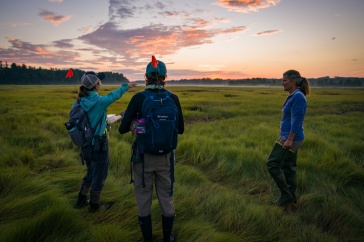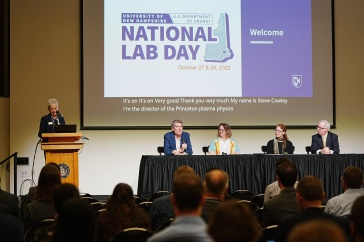Buzzing bees are one of the surest signs of spring. But that seasonal soundtrack is increasingly in danger, according to Sandra Rehan, assistant professor of biology and director of the Bee Lab at UNH.

“The overall theme is that bees are not doing well,” Rehan says. “In general, they are declining locally, nationally and worldwide, and we do not have sufficient data to protect the remaining species and populations at risk.”
Rehan and the Bee Lab’s team of researchers have made it their mission to collect data on bee populations, both in New Hampshire and around the world. Recent research from the lab, including a survey of bee species in New Hampshire’s White Mountains region, and a study by graduate student and Bee Lab researcher Wyatt Shell on invasive and endangered bee species in Hawaii, will bolster efforts to conserve wild bee populations — the “unsung heroes of the pollinator world,” as Rehan calls them.
Earlier this year, The Bee Lab published the results of the first-ever assessment of the state’s native bee population in the White Mountain National Forest in the Journal of Insect Science. In one weekend, 30 volunteers from five states collected more than 1,000 bee specimens. The group found nearly 140 species of native bees, two of which — the yellow-banded bumble bee (Bombus terricola) and the golden northern bumblebee (Bombus fervidus) — are listed in the New Hampshire Fish and Game Department’s Wildlife Action Plan as species of greatest conservation need.
“In just one weekend, we were able to show a rich diversity of species,” Rehan says.
Wild bees are the engine on which the world runs — as pollinators, they keep crops growing and make ecosystems function. They’re in trouble, though — the rusty patched bumble bee, once a common sight in New Hampshire and around the country, was the first bee species to be added to the federal Fish and Wildlife Service’s endangered species list this year. But while wild bees are vital, there is a dearth of data on what they need to survive, according to Rehan.
Efforts like the White Mountain survey help fill that gap. UNH has 150 years’ worth of bee records and more than 21,000 specimens collected from across the state, but the picture of which bees are here, which aren’t, and why, is incomplete, Rehan adds. Some species are generalist pollinators, while others pollinate specific flowers. That information, along with other data, provides a holistic look at bee populations.
Why Wild?
Not all pollinators are the domesticated, hive-dwelling honeybees that dot the backyards and farm fields of our landscape. In fact, unmanaged, wild bee species are the workhorses of the agricultural world, doing most of the pollination that occurs in North America. And they’re the only ones who can do it. Sandra Rehan, assistant professor of biology and director of the UNH Bee Lab, cites a growing misconception that introducing honeybee hives will help ameliorate the problem of bee declines. “Although a noble intention, the introduction of non-native species will only further harm wild bee communities through competitive exclusion from shared flower patches and possible pathogen spill over from honey bee hives into wild bee communities.”
That’s why UNH bee researchers are laser-focused on finding out more about the decline of wild bees.
“A lot of bee species that were historically in the state are no longer here … and so we have to ask, is it a mismatch of flower availability? Is it land use? Climate change?” Rehan says. “The biggest gap in our knowledge is that we do not know their natural habitat requirements or their food resources. If we can define their diet and their habitat requirements, we can better protect what they need.”
Bee Lab researchers are pursuing those questions across the country. With more than 20,000 bee species worldwide, with 4,000 of those in North America, there is plenty to discover. Shell and Rehan’s study of invasive and endangered bee species in Hawaii was recently published in the journal Pacific Science. The research provides a detailed analysis of Ceratina smaragdula, a small green carpenter bee that’s not native to the Hawaiian islands. According to Shell, learning more about C. smaragdula can help reveal its impact on native Hawaiian bees and plants. Seven bee species in Hawaii were recently classified as endangered.
“Because C. smaragdula is a generalist pollinator, it could be all the more potent a threat” to native bee species on the islands, Shell says. “At best, it is having a neutral effect; at worst, it could be exacerbating ongoing native species loss, for both plants and pollinators. But we really do not know.”
Rehan hopes the lab’s research will keep bees buzzing everywhere, from the lakes and mountains of New Hampshire to the islands of Hawaii and beyond.
“There is a lot of interest from students, citizen scientists and communities about conserving bees,” she says. “I am happy to advocate for wild bees — people cannot conserve something if they do not know anything about it.”
The Rehan lab is funded by NSF, USDA, National Geographic and public donations. This material is based upon work supported by the NH Agricultural Experiment Station, through joint funding of the National Institute of Food and Agriculture, U.S. Department of Agriculture, under award number 1004515, and the state of New Hampshire.
Connect with the Bee Lab and check out its Guide to Native Bees on New England.
-
Written By:
Larry Clow '12G | UNH Cooperative Extension



















































